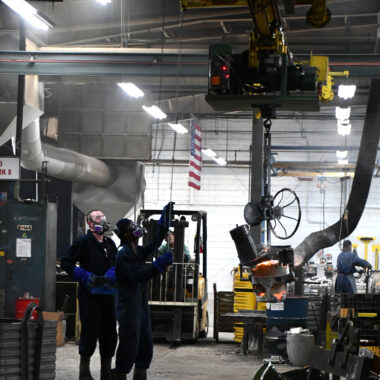Changing Visions right into Truth: Aluminum Casting Illinois
Changing Visions right into Truth: Aluminum Casting Illinois
Blog Article
Mastering the Craft: Specialist Tips for Flawless Light Weight Aluminum Spreading Outcomes
In the realm of aluminum precision, spreading and competence are critical to attain remarkable outcomes. Mastering the craft needs a thorough understanding of the tools and tools at one's disposal, a keen eye for preparing the light weight aluminum alloy to exact specs, and a deft hand in utilizing optimal casting techniques.
Necessary Tools and Devices
Light weight aluminum casting needs details tools and devices to ensure precision and effectiveness while doing so. Essential devices include a crucible, heater, ladle, and mold and mildew. The crucible, usually constructed from graphite or ceramic products, withstands high temperatures required to thaw aluminum. A well-insulated furnace efficient in reaching temperature levels over 1200 ° C is crucial to liquefy the steel. The mold, usually made of steel or sand, shapes the liquified light weight aluminum right into the desired type. A ladle is made use of to move the fluid steel from the crucible to the mold without spillage.
In addition, tools like handwear covers, tongs, and aprons are required to ensure the safety and security of operators working with molten aluminum. Spending in high-quality devices and devices not just enhances the accuracy of light weight aluminum casting yet also adds to a more safe and reliable production procedure.
Preparing the Light Weight Aluminum Alloy
To guarantee the success of the aluminum casting process, meticulous preparation of the alloy is paramount. The first step in preparing the aluminum alloy is to carefully select the appropriate kind of light weight aluminum based on the features needed for the last product.
After cleaning, the next essential step is to heat up the aluminum to the appropriate temperature level for spreading. This procedure, called alloy melting, guarantees that the aluminum is in its molten kind and prepared for casting (aluminum casting illinois). Additionally, regulating the temperature level during melting is important to avoid overheating or underheating, which can bring about flaws in the final item. On the whole, precise preparation of the aluminum alloy sets the structure for a successful spreading procedure and top notch end outcomes.
Optimum Casting Methods
Implementing specific casting strategies is necessary for accomplishing high-quality cause aluminum spreading processes. One vital technique is ensuring correct mold prep work. This involves careful cleaning and finish of the mold to stop light weight aluminum from sticking and make sure smooth spreading. Furthermore, regulating the pouring temperature level is important. The light weight aluminum should be heated up to the optimum temperature to decrease issues like shrinkage and porosity in the final actors.
Additionally, preserving regular putting speed and pressure is essential to attaining harmony in the actors item. Constant and sluggish putting assists prevent turbulence and air entrapment, which can result in imperfections. Another vital facet is the use of degassing agents to remove pollutants and gases from the molten aluminum, causing a cleaner end product.

Achieving Smooth Surface Area Finishes
For suppliers seeking to enhance the visual allure and high quality of their light weight aluminum castings, accomplishing smooth surface area finishes is a vital aspect adhering to specific casting methods and proper cooling procedures. One trick technique to achieve smooth surface area coatings is by utilizing high-quality mold and mildews that are effectively prepared and kept. The mold surface area need to be thoroughly cleaned and coated with launch representatives to avoid imperfections moving onto the actors light weight aluminum throughout the cooling procedure.
Moreover, managing the cooling price of the aluminum spreading is essential for achieving a smooth surface finish. Fast air conditioning can lead to thermal slopes that lead to appear defects, while slow cooling might trigger microstructural issues - aluminum casting illinois. By applying controlled cooling processes, such as using air or water quenching approaches, suppliers can guarantee that the light weight aluminum solidifies evenly, lowering the chance of surface imperfections
In enhancement to mold and mildew quality and cooling procedures, post-casting therapies like shot blasting or chemical etching can further fine-tune the surface coating of aluminum castings. These go to this site methods aid smooth out any type of staying roughness or contaminations, resulting in a remarkable look that meets the best standards.
Top Quality Control and Troubleshooting

In the realm of troubleshooting, it is important to have a thorough understanding of typical defects that can happen throughout aluminum casting, such as shrinking, surface, or porosity irregularities. Constant renovation via quality control and repairing practices is essential to attaining flawless outcomes in light weight aluminum spreading.
Conclusion
In final thought, mastering the craft of light weight aluminum spreading calls for important devices and devices, proper prep work of the aluminum alloy, ideal spreading techniques, achieving smooth surface finishes, and carrying out high quality article source control steps. By complying with these specialist pointers, perfect outcomes can be attained in aluminum casting procedures. Quality assurance and troubleshooting are very important facets Web Site to consider to make certain regular and premium outcomes in light weight aluminum spreading projects.
The very first action in preparing the light weight aluminum alloy is to thoroughly select the suitable kind of aluminum based on the attributes needed for the final item.Executing specific casting techniques is crucial for attaining premium outcomes in light weight aluminum spreading procedures. By mastering these optimal spreading methods, manufacturers can consistently produce perfect light weight aluminum castings.
For producers looking for to improve the aesthetic allure and top quality of their aluminum spreadings, accomplishing smooth surface finishes is a crucial aspect adhering to specific casting methods and correct air conditioning procedures.In conclusion, grasping the craft of light weight aluminum spreading requires essential tools and tools, correct preparation of the aluminum alloy, optimal casting strategies, achieving smooth surface finishes, and carrying out quality control measures.
Report this page